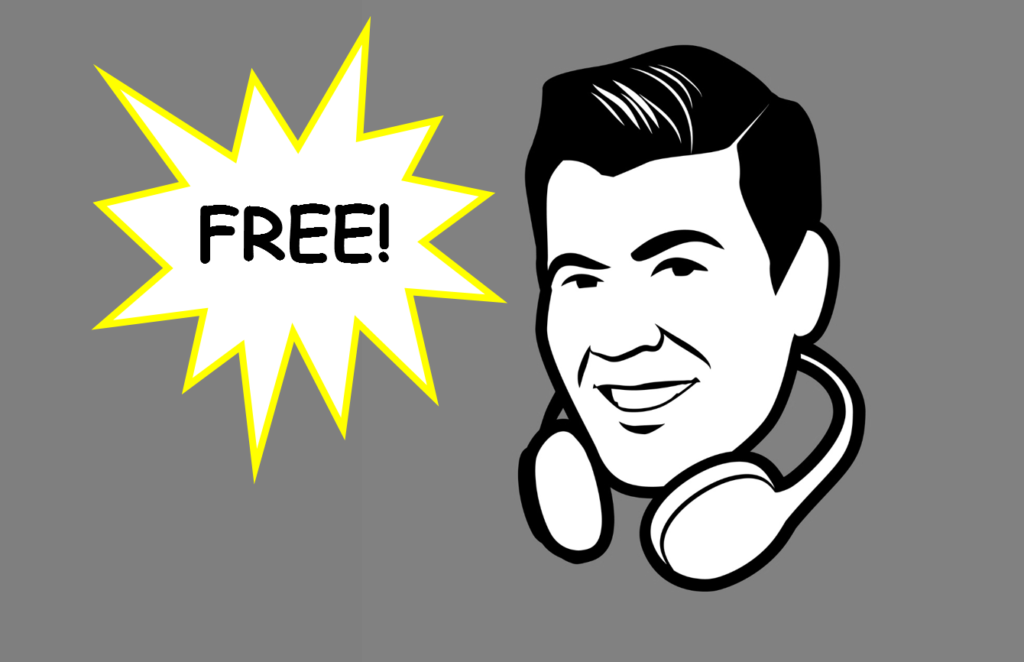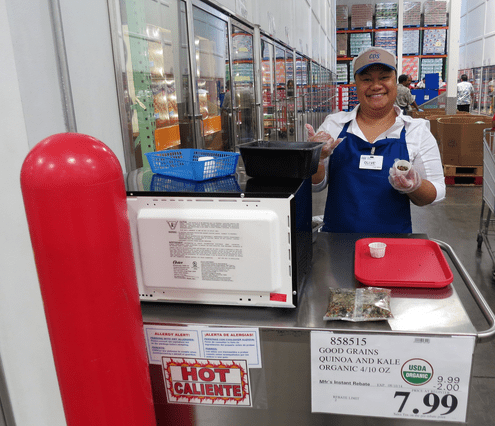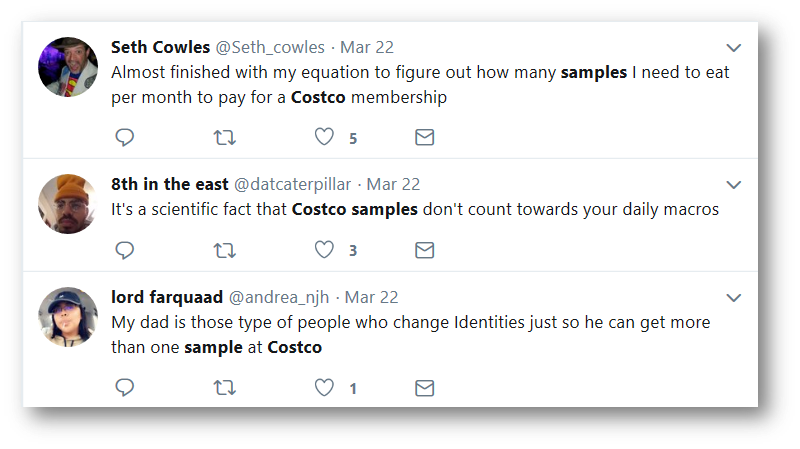
Go figure.
Two blog posts about Costco in the last 30 days. A few weeks back, we talked about how Costco has mastered the element of surprise. By carrying items you simply can’t buy at other big box stores – caskets, survival kits,
But I left out one of the things I most enjoy enjoy about going to Costco – the free samples.
They’re the only retail store of their kind that makes the investment in actually giving product away on a regular basis. Myself excluded, of course, there are people who say they go to Costco to graze on the free samples, often deviously stopping to get seconds on the same tasty item. So, why does Costco offer a consistent diet of free food samples?
That what Business Insider’s Mary Hanbury wanted to know. And in the process, she learned Costco’s free sample policy turns out to be great business for the chain. Its shoppers love it, and it sells product.
Here are a half dozen key reasons why Costco’s free samples work – and how radio could take advantage of the same benefits:
1. Free is good
Sure you have to pay a membership fee to Costco, but like Amazon Prime’s $99 initiation fee, you quickly forget about that and start shopping – and sampling free food items, strategically placed around the warehouse – many of which are very tasty.
Customers feel like in addition to their other Costco benefits (variety, pricing, bulk quantities), they get a little something for nothing every time they stroll up and down the aisles. And like that surprise element we talked about in the earlier post, you never know what delectable is waiting for you around the corner.
2. It sets them apart
We don’t have access to Costco’s consumer brand research, but clearly the samples stand out as a key differentiator for Costco. It sets them apart from the other stores in the category, providing them with a unique feature. In a competitive, cut-throat industry, that’s a good thing.
And in a world where Amazon will increasingly make its massive footprint known, Costco’s unique advantage of free samples is something consumers will remember – and count on. It’s part of the shopping experience you just can’t get with ecommerce.

3. It actually works
While many say they shop at Costco just to grab a free meal on the run, free sampling leads to sales. While the company is tight-lipped about how complimentary eats turn into revenue, Hanbury estimates they could boost sales of an item as much as 600%. Some believe that can go even higher.
And of course, once you’re in the store, you end up buying other products, too. If it didn’t work, Costco wouldn’t do it.
4. It leads to loyalty
The overall Costco experience is enhanced by the free samples. According to Hanbury, it also induces more brand loyalty to the big box chain. In a business environment where that attribute is mighty hard to come by, Costco makes a relatively small investment in sampling in order to generate a deeper connection to their brand.
5. It’s viral
Yes, people talk about the samples – a lot. That’s especially true in the social sphere, where consumers love to talk about how they take advantage of Costco’s free sample service.
And in radio, we know too well the power of social sharing, positive buzz, and our customers doing the selling for us. Who wanted want to check out Costco (and its free food samples) after reading these tweets?

6. It’s personal
You’re in a store, you’re tasting food, and you’re talking to a demonstrator who’s telling you all kinds of fun, nutritious factoids about what you’re noshing on. Hanbury notes some shoppers even feel “pressure to buy the product” they’re munching on.
There’s nothing online or virtual about this selling process. The food is in your face, and the product is neatly stacked up next to the sampling station. It’s a very easy move to throw it right in your basket and keep shopping.
So, what does this have to do with broadcast radio?
Many of these same advantages are in play for Marconi’s medium, too.
So, let’s break it down. First, the FREE piece.
As we learn every year in our Techsurveys, radio consumers point to all sorts of benefits when explaining why they listen to broadcast radio stations in the midst of all those media choices. And near the top of the list is that radio is free.
There are no subscription fees, credit card charges, or hidden costs associated with AM/FM radio listening. You don’t even have to give up your personal information in order to listen to it.
And like Costco’s free sample program, the free piece sets radio apart from Sirius/XM, Pandora, Spotify, and pretty much every other form of audio entertainment these days, most of which have their hands on our wallets and purses.
When radio is on its game, it’s also personal, eye to eye, making contact with listeners on the phone, socially, and in person at events. The ability to experience radio in person is something you simply cannot derive from an online service.
Radio can also be social. People don’t talk about radio stations as much as they do corned beef and cabbage samples from Costco. There is a social component in play if stations and personalities do their jobs and give listeners something to “socialize” about.
And then there’s the SAMPLES part.
Seemingly, that’s the one area where perhaps Costco has the edge on most radio stations. In a retail environment, people physically visit stores. But in the world of radio, they simply turn it on from wherever they are on myriad devices. They never visit the “warehouse.”
But shouldn’t that also be part of the total radio station experience? Couldn’t radio benefit from giving away its own free samples – in the form of station tours, watching an hour of the morning show, and perhaps even sitting in on a music meeting.
I moderated listener advisory board groups last week for an Alternative station that recently moved into beautiful new facilities. At the end of each session, respondents were paid cash and swag. But it was the station tour that interested them. They wanted to see “where the sausage is made” – the studios, the jock lounge, the P.D.’s office.
And these people were “jaded Millennials who don’t listen to radio.” Except they do, and they soaked up every minute of the experience. They were taking pictures, and I’m assuming posting them on their social media pages. For offering up some inexpensive “free samples,” the station was generating loyalty, buzz, and an experience.
Radio stations are mostly fun, exciting, electric places to visit – from the gold and platinum records on the walls to the unique vibe you can only feel when you set foot inside an air studio.
Radio’s even better than visiting a big box warehouse and chowing down sweet and sour shrimp.
- What To Do If Your Radio Station Goes Through A Midlife Crisis - April 25, 2025
- A 2020 Lesson?It Could All Be Gone In A Flash - April 24, 2025
- How AI Can Give Radio Personalities More…PERSONALITY - April 23, 2025




Leave a Reply